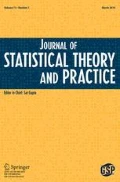Abstract
We address statistical issues in attributing revenue to marketing channels and inferring the importance of individual channels in customer journeys toward an online purchase. We describe the relevant data structures and introduce an example. We suggest an asymmetric bathtub shape as appropriate for time-weighted revenue attribution to the customer journey, provide an algorithm, and illustrate the method. We suggest a modification to this method when there is independent information available on the relative values of the channels. To infer channel importance, we employ sequential data analysis ideas and restrict to data which ends in a purchase. We propose metrics for source, intermediary, and destination channels based on two- and three-step transitions in fragments of the customer journey. We comment on the practicalities of formal hypothesis testing. We illustrate the ideas and computations using data from a major UK online retailer. Finally, we compare the revenue attributions suggested by the methods in this article with several common attribution methods.
Similar content being viewed by others
References
Abhishek, V., P. Fader, and K. Hosanagar. 2012. The long road to online conversion: A model of multi-channel attribution. https://doi.org/10.2139/ssrn.2158421.
Agrawal, R., and R. Srikant. 1995. Mining sequential patterns. Technical report, IBM Research Division, Almaden Research Center.
Berendt, B., and M. Spiliopoulou. 2000. Analysis of navigation behaviour in web sites integrating multiple information systems. VLDB J., 9, 1–56.
Dalessandro, B., C. Perlich, O. Stitelman, and F. Provost. 2012. Causally motivated attribution for online advertising. In Proceedings of the Sixth International Workshop on Data Mining for Online Advertising and Internet Economy, ADKDD’ 12, 7: 1–7:9. ACM, New York, NY. doi:10.1145/2351356.
Goodman, L. A. 1965. On simultaneous confidence intervals for multinomial proportions. Technometrics, 7, 2–247.
Gunduz, S., and M. T. Ozsu. 2003. A web page prediction model based on click-stream tree representation of user behavior. In Proceedings of the Ninth ACM SIGKDD International Conference on Knowledge Discovery and Data Mining, Washington, DC, August 24–27, 2003, 535–540.
Gunduz-Oguducu, S., and M. T. Ozsu. 2006. Incremental click-stream tree model: Learning from new users for web page prediction. Distrib. Parallel Databases, 19, 1–5.
Hahsler, M., B. Grün, and K. Hornik. 2005. Arules—A computational environment for mining association rules and frequent item sets. Journal of Statistical Software, 14(15), 1–25.
Hou, C. D., J. Chiang, and J. J. Tai. 2003. A family of simultaneous confidence intervals for multinomial proportions. Comput. Stat. Data Anal., 43, 1–29.
Internet Advertising Bureau UK. 2013. 2012 Online Adspend full year results. https://doi.org/www.iabuk.net/research/library/2012-full-year-digital-adspend-results
Jamalzadeh, A. 2012. Analysis of clickstream data. PhD thesis, Durham University, Durham, UK.
Moe, W. W. 2003. Buying, searching or browsing: Differentiating between online shoppers using in-store navigational clickstream. J. Consumer Psychol., 13(1&2), 29–39.
Osur, A., E. Riley, T. Moffett, S. Glass, and E. Komar. 2012. The Forrester Wave Interactive Attribution Vendors Q2 2012. Technical report, Forrester Research, Inc.
Shao, X., and L. Li. 2011. Data-driven multi-touch attribution models. In Proceedings of the 17th ACM SIGKDD International Conference on Knowledge Discovery and Data Mining, 258–264.
Wang, W., and J. Yang. 2005. Mining sequential patterns from large data sets. New York, NY: Springer.
Wooff, D. A., and A. Jamalzadeh. 2013. Robust and scale-free effect sizes for non-normal two-sample comparisons, with applications in e-commerce. J. App. Stat., 40, 11–2495.
Xu, L., J. A. Duan, and A. B. Whinston. 2012. Path to purchase: A mutually exciting point process model for online advertising and conversion. https://doi.org/10.2139/ssrn.2149920.
Zaki, M. J. 2000a. Sequence mining in categorical domains: Algorithms and applications. In Sequence learning: Paradigms, algorithms, and applications, volume 1828 of LNAI State-of-the-Art-Survey, ed. R. Sun and L. Giles, 162–187. Heidelberg, Germany: Springer-Verlag.
Zaki, M. J. 2000b. Sequence mining in categorical domains: Incorporating constraints. In Proceedings of the 9th International Conference on Information and Knowledge Management, Washington DC, 422–429.
Author information
Authors and Affiliations
Corresponding author
Additional information
Color versions of one or more of the figures in the article can be found online at https://doi.org/www.tandfonline.com/ujsp.
Rights and permissions
About this article
Cite this article
Wooff, D.A., Anderson, J.M. Time-Weighted Multi-Touch Attribution and Channel Relevance in the Customer Journey to Online Purchase. J Stat Theory Pract 9, 227–249 (2015). https://doi.org/10.1080/15598608.2013.862753
Received:
Accepted:
Published:
Issue Date:
DOI: https://doi.org/10.1080/15598608.2013.862753




